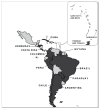National Antimicrobial Consumption in Latin America and the Caribbean: Measurements and Results from 2019-2022
- PMID: 40149051
- PMCID: PMC11939307
- DOI: 10.3390/antibiotics14030240
National Antimicrobial Consumption in Latin America and the Caribbean: Measurements and Results from 2019-2022
Abstract
Antimicrobial resistance (AMR) represents a major threat to health with significant global economic and safety implications. One of the major drives of this resistance is the misuse and overuse of antimicrobials. Background/Objectives: In this sense, WHO proposed to it members to estimate the antimicrobial consumption (AMC) at each country level, in order to help local authorities in their decision making related to AMR control. Although this program is already installed worldwide, in the American continent, the rate of countries' inclusion has been delayed. This paper describes the efforts of Latin American & Caribbean countries in terms of AMC local assessment. Methods: AMC data collection was done as per the GLASS tool proposed by WHO. Analysis was performed using Daily Defined Dose each one thousand inhabitants day (DID) for global, therapeutical group or each antibiotic. Access, Watch and target Reserve (AWaRe) WHO classification was applied after data collection. Results: 13 countries were included during the period 2019-2022. The global DID ranged from 2.55 DID to 36.26 DID. The trend of this consumption did downward along the years. One of the factors than impacted the AMC was the COVID-19 pandemic. The most problematic antimicrobial misuse was seen in certain beta lactams and macrolides, like ceftriaxone and azithromycin. Regarding the AWaRe classification, 5 out of 13 countries accomplished the target until 2023 of 60% consumption for "Access antimicrobial's group by 2023). This data helped local health managers to propose changes for better control of the AMR problem (ceftriaxone usage limitations in Peru, antimicrobial law in Argentina, etc.). Conclusions: The first steps towards AMC country's assessment has been initiated. The present work provided essential inputs to local health authorities for decision making related to AMR control. It will be necessary to keep applying this results in regulate antibiotic usage at country level, as well as enrolling more countries in the AMC project.
Keywords: AWaRe; Caribbean; Latin America; antimicrobial; consumption; resistance.
Conflict of interest statement
The authors declare no conflicts of interest.
Figures


References
-
- Global Antimicrobial Resistance and Use Surveillance System (GLASS). World Health Organization (WHO) 2023. [(accessed on 22 July 2024)]. Available online: https://www.who.int/initiatives/glass.
-
- Global Action Plan on Antimicrobial Resistance. World Health Organization (WHO). 1 January 2016. [(accessed on 22 July 2024)]. Available online: https://www.who.int/publications/i/item/9789241509763.
-
- Antimicrobial Resistance. World Health Organization (WHO). 21 November 2023. [(accessed on 22 July 2024)]. Available online: https://www.who.int/news-room/fact-sheets/detail/antimicrobial-resistance.
Grants and funding
LinkOut - more resources
Full Text Sources

